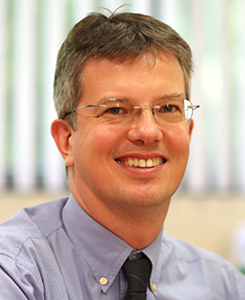
THORSTEN WOHLAND
Professor
Contact Information:
Department of Biological Sciences
National University of Singapore
14 Science Drive 4
Singapore 117543
Lab:
6516 1248
6779 2486
dbswt@nus.edu.sg
Research Interests
Biophysical Fluorescence
The research in my group is directed towards biophysics with an emphasis on biophysical fluorescence. This highly interdisciplinary domain requires the interaction of chemists, physicists, and biologists. Only a concerted effort of these three groups will allow us to tackle the problems in the life sciences. The close proximity of departments of biology, biochemistry, chemistry, and physics at the National University of Singapore on one side and the research institutes (RIs) on the other side, allows us to develop physical and chemical methods for the study of biological questions on one hand and to apply these methods to the frontier in biology on the other hand. Our interests lie accordingly in the different areas that interact freely to advance this research field.
Construction and development of new optical tools.
Optical Spectroscopy is one of the most sensitive tools available in the life sciences. Proteins can be studied not only in ensembles but as well on the single molecule level. Besides using well established methods in our group (e.g. Fluorescence Correlation Spectroscopy, Fluorescence Resonance Energy Transfer), we also plan to develop new spectroscopy and microscopy tools and new mathematical procedures to study proteins on a single molecule level in vitro and in vivo.
Study of selected proteins and protein complexes on a single molecule level and in living cells.
In collaboration with the Department of Biological Sciences, the Department of Microbiology and the RIs we will study the properties of selected proteins and peptides to elucidate their function on a molecular level. At the moment we concentrate on either antimicrobial peptides and their interaction with bacterial membranes, or on the study of transmembrane proteins (G-protein coupled receptors, growth factors) and their structure, function and interactions.
One of the most interesting questions in biology is the relationship between the structure and function of proteins. With the fluorescence tools developed in our group we hope to shed some light on this question by in vitro experiments. In a complementary approach we will study the proteins in living cells because proteins are in many cases very sensitive to their environment and only when studied under physiological conditions can we determine their exact function.
Representative Publications
2021
-
Lyu X, Wang J, Wang J, Yin YS, Zhu Y, Li LL, Huang S, Peng S, Xue B, Liao R, Wang SQ, Long M, Wohland T, Chua BT, Sun Y, Li P, Chen XW, Xu L, Chen FJ, Li P.“A gel-like condensation of Cidec generates lipid-permeable plates for lipid droplet fusion.”Developmental Cell. 2021. DOI: doi.org/10.1016/j.devcel.2021.08.015.
-
Yong XE, Palur VR, Anand GS, Wohland T, Sharma KK.“Dengue virus 2 capsid protein chaperones the strand displacement of 5′-3′ cyclization sequences.”Nucleic Acids Res. 2021. DOI: 10.1093/nar/gkab379.
-
Dhasmana D, Veerapathiran S, Azbazdar Y, Nelanuthala AVS, Teh C, Ozhan G, Wohland T.“Wnt3 Is Lipidated at Conserved Cysteine and Serine Residues in Zebrafish Neural Tissue.”Front Cell Dev Biol. 2021. DOI: 10.3389/fcell.2021.671218.
-
Sankaran J, Balasubramanian H, Tang WH, Ng XW, Röllin A, Wohland T.“Simultaneous Spatiotemporal Super-Resolution and Multi-Parametric Fluorescence Microscopy.”Nat Commun. 2021. DOI: 10.1038/s41467-021-22002-9. Protocol for live cell preparation available Here.
-
Hackl S, Ng XW, Lu D, Wohland T, Becker CFW.“Cytoskeleton-dependent clustering of membrane-bound prion protein on the cell surface.”J Biol Chem.2021. DOI: 10.1016/j.jbc.2021.100359.
-
Koh A, Tao S, Jing Goh Y, Chaganty V, See K, Purushothaman K, Orbán L, Mathuru AS, Wohland T, Winkler C.“A Neurexin2aa deficiency results in axon pathfinding defects and increased anxiety in zebrafish.”Hum Mol Genet.2021. DOI: 10.1093/hmg/ddaa260.
2020
-
Yong XE, Raghuvamsi PV, Anand GS, Wohland T, Sharma KK.“Dengue virus strain 2 capsid protein switches the annealing pathway and reduces the intrinsic dynamics of the conserved 5’ untranslated region.”RNA Biology.2020. DOI: 10.1101/2020.06.19.160978.
-
Veerapathiran S, Teh C, Zhu S, Kartigayen I, Korzh V, Matsudaira PT, Wohland T.“Wnt3 distribution in the zebrafish brain is determined by expression, diffusion and multiple molecular interactions.”eLife. 2020. DOI: 10.7554/eLife.59489.
-
Vidaillac C, Yong VFL, Aschtgen MS, Qu J, Yang S, Xu G, Seng ZJ, Brown AC, Ali MK, Jaggi TK, Sankaran J, Foo YH, Righetti F, Nedumaran AM, Mac Aogáin M, Roizman D, Richard JA, Rogers TR, Toyofuku M, Luo D, Loh E, Wohland T, Czarny B, Horvat JC, Hansbro PM, Yang L, Li L, Normark S, Henriques Normark B, Chotirmall SH.“Sex Steroids Induce Membrane Stress Responses and Virulence Properties in Pseudomonas aeruginosa.”mBio. 2020. DOI: 10.1128/mBio.01774-20.
-
Wohland T.“Splitting the Difference: Sorting Photons to Improve Quantitative Measurements in Correlation Spectroscopy.”Biophys J. 2020. DOI: 10.1016/j.bpj.2020.08.017.
-
Nielsen CD, Dhasmana D, Floresta G, Wohland T & Cilibrizzi A.“Illuminating the path to target GPCR structures and functions.”Biochemistry. 2020. DOI: 10.1021/acs.biochem.0c00606.
-
Gupta A, Phang IY, Wohland T.“To Hop or not to Hop: Exceptions in the FCS Diffusion Law.”Biophys J. 2020. DOI: 10.1016/j.bpj.2020.04.004.
-
Sankaran J, Wohland T.“Fluorescence strategies for mapping cell membrane dynamics and structures.”APL Bioengineering. 2020. DOI: 10.1063/1.5143945.
-
Gupta A, Muralidharan S, Torta F, Wenk MR, Wohland T.“Long acyl chain ceramides govern cholesterol and cytoskeleton dependence of membrane outer leaflet dynamics.”BBA Biomembranes. 2020, 1862 (3), 183153-183153. DOI: 10.1016/j.bbamem.2019.183153.
-
Gupta A, Korte T, Herrmann A, Wohland T.“Plasma membrane asymmetry of lipid organization: fluorescence lifetime microscopy and correlation spectroscopy analysis.”J Lipid Res. 2020. DOI: 10.1194/jlr.D119000364.
